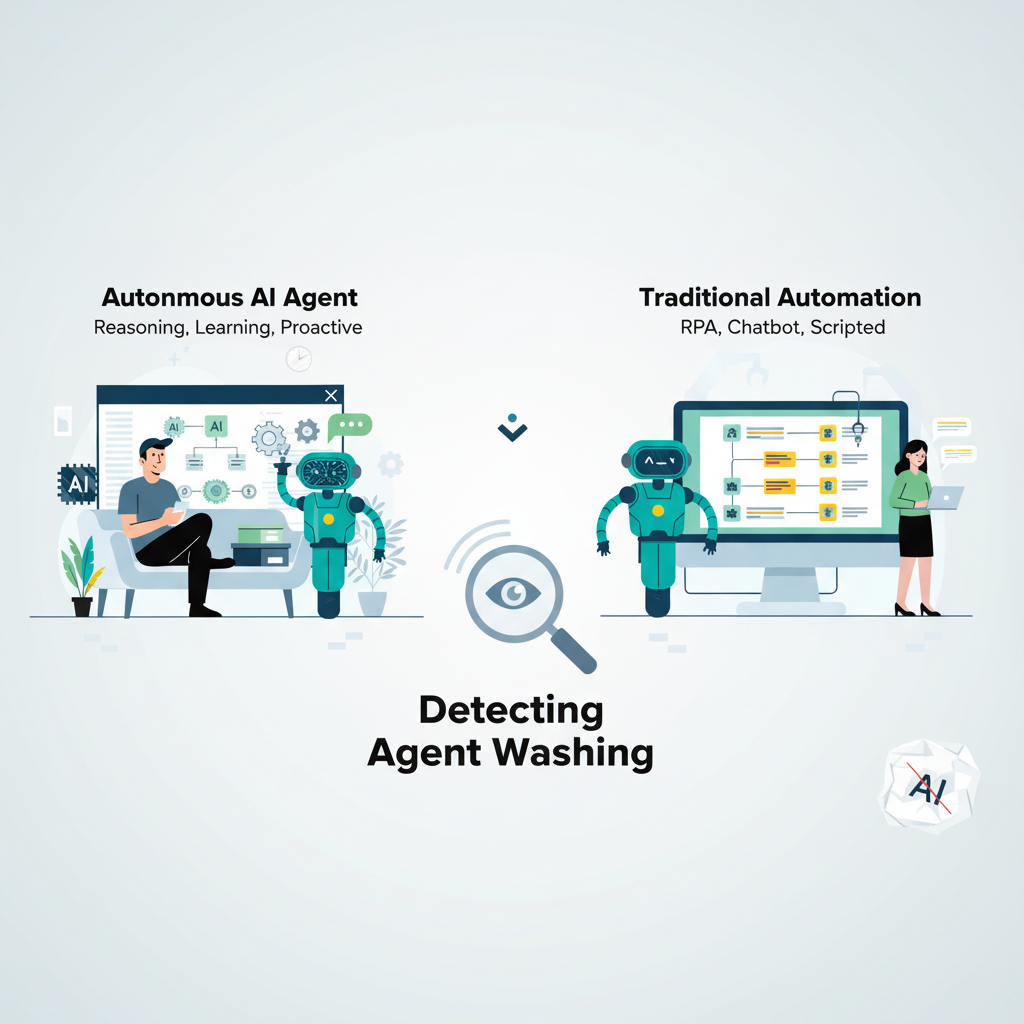This guide is part of our comprehensive Understanding AI Agents and Autonomous Systems resource, where we explore the complete landscape of autonomous systems. Within this series, it provides technical criteria for evaluating autonomy claims, including a practical framework for identifying “agent washing”—the practice of mislabelling systems that lack genuine autonomous decision-making.
The term “AI agent” has become inescapable in enterprise technology. Every vendor claims to have agents now, but definitions remain inconsistent and often deliberately misleading. The technical distinctions between genuine AI agents and rebranded automation are murky at best.
This matters because the difference between implementing genuine AI agents and deploying glorified chatbots isn’t just semantics—it’s the difference between transformative capability and expensive disappointment.
What Exactly Is an AI Agent and How Does It Differ From Automation?
AI agents are software systems that perceive their environment, make autonomous decisions based on defined goals, and take actions without explicit human instruction for each decision. The core distinction between agents and traditional automation comes down to autonomy: traditional automation executes predetermined rules triggered by specific conditions, while AI agents use reasoning to evaluate situations and choose actions dynamically.
Rule-based automation says “if X happens, do Y.” An AI agent says “here’s my goal; let me work out what needs to happen based on the current situation.” This shift from reactive, instruction-following systems to proactive, goal-directed systems represents a fundamental architectural change.
Modern AI agents leverage large language models as reasoning engines, enabling genuine decision-making rather than pattern matching or rule execution. Consider the difference: a traditional chatbot answers customer questions when asked. An AI agent autonomously processes an entire support ticket from intake through resolution—reading, reasoning, executing solutions, and confirming—without waiting for human prompts at each step.
Understanding where a system sits on the autonomy spectrum—from rule-based automation through augmented automation to fully autonomous agents—is crucial for making informed decisions about which technology to deploy.
What Are the Core Architectural Components That Enable AI Agent Autonomy?
Three core components enable autonomous decision-making in AI agents: a reasoning engine for evaluating situations and generating plans, memory systems for retaining context and learning from interactions, and tool use capabilities for taking real-world actions.
The reasoning engine—typically a large language model—sets modern AI agents apart from earlier automation. It processes environmental information, applies logical inference, and generates plans to achieve goals. Unlike rule-based systems that execute predetermined logic paths, the reasoning engine evaluates novel situations and determines responses based on learned principles rather than explicit programming.
Memory systems operate at multiple levels: short-term context (maintaining awareness across steps), long-term learning (accumulating knowledge from past interactions), and environmental awareness (current system state). Contemporary stacks combine expanded context windows (1M+ tokens), vector databases, and retrieval-augmented generation to deliver this capability.
Tool use—often called function calling—enables agents to interact with external systems, APIs, databases, and services. This turns reasoning into actionable outcomes. The critical distinction here: genuine agents decide which tools to use and when based on reasoning, not just executing API calls via predefined rules.
These three components work together in a reinforcement loop: reasoning determines what actions to take, memory informs what worked previously in similar situations, and tools execute the actions in the world.
For complex scenarios where multiple agents work in concert, this architecture becomes even more powerful. Learn more about multi-agent orchestration, where agents coordinate actions to solve problems too complex for single-agent approaches.
Contrast this with traditional RPA, which uses only predefined rules (no reasoning engine), has no memory adaptation (executes the same rules repeatedly without learning), and has limited tool integration (calls APIs based on rule triggers, not reasoned decisions). The architectural difference is fundamental, not superficial.
How Do AI Agents Make Decisions Independently Without Being Programmed for Every Scenario?
AI agents use large language models to engage in reasoning—processing available information, weighing options, evaluating trade-offs, and selecting actions dynamically based on goals. This differs fundamentally from rule-based systems that follow predetermined if-then logic.
Reasoning-based systems can evaluate novel situations they were never explicitly programmed for. The LLM’s ability to recognise patterns across vast training data enables it to generate reasonable decisions in new contexts by applying learned principles rather than executing hardcoded instructions.
Independent decision-making requires four elements:
- Clear goal definition: The agent needs to know what it’s trying to achieve and what constraints apply.
- Environmental awareness: Input about the current situation—what’s happening right now that the agent needs to respond to.
- Reasoning capability: The ability to evaluate options, consider trade-offs, and select the best action given the goals.
- Tool access: The ability to take action in the world based on reasoned decisions.
Consider a practical example: a customer support ticket combines a billing question, technical issue, and feature request. Traditional RPA fails because this specific combination wasn’t programmed. An AI agent reasons through it: “This ticket has three components. I can handle the billing and technical issues now, but I’ll log the feature request separately for product review.”
A common misconception is that autonomous decision-making means unpredictable or out-of-control systems. This is incorrect. Autonomous agents operate within defined goal constraints; the autonomy refers to how they achieve goals, not whether they can modify the goals themselves. Well-designed agents include safety constraints, escalation rules, and human oversight for high-risk decisions. Understanding deploying agents securely with frameworks like Non-Human Identity (NHI) is essential for autonomous operation at scale.
What Is Agent Washing and How Can You Detect When Vendors Are Misrepresenting Their Systems?
As “AI agent” terminology gains market traction, vendors increasingly rebrand existing products without changing underlying architecture—a practice called “agent washing.” Unlike general AI marketing exaggeration, agent washing specifically misrepresents architectural capability regarding autonomy and decision-making.
Here’s a practical detection framework:
Red Flag 1: No explicit reasoning engine. If the vendor can’t articulate how their system reasons about novel situations, it’s likely agent washing. Genuine agents use LLMs or similar reasoning engines as a core component.
Red Flag 2: Inability to adapt outside predefined rules. Ask vendors to demonstrate how their system handles unprogrammed scenarios. If they can only execute predefined paths, it’s agent washing.
Red Flag 3: No goal-oriented autonomous action. If the system is purely reactive and waits for you to tell it what to do at each stage, it’s not an agent regardless of marketing claims.
Red Flag 4: Reactive-only architecture. Systems that only respond to queries but never initiate actions are chatbots, not agents.
Genuine AI agents demonstrate: (1) Independent decision-making in novel situations; (2) Goal-directed behaviour across multiple steps; (3) Tool use integrated with reasoning; (4) Adaptive memory that improves performance over time.
Test vendors by presenting unprogrammed scenario variations. If the system only executes predefined paths or fails entirely, it’s agent washing. If it reasons through the situation and adapts, it’s likely genuine.
Common misrepresentations include:
- “Intelligent chatbots” marketed as agents: These remain reactive, conversation-initiated systems. Conversational skill doesn’t make something an agent.
- RPA with “AI” labels claiming autonomy: Still rule-based, requiring explicit programming for each scenario. Adding “AI” to data extraction doesn’t create autonomous reasoning.
Why this matters: incorrect technology decisions lead to wasted budgets, unmet expectations, and organisational cynicism about AI. Deploying rebranded RPA as an “agent” means encountering all the traditional limitations of rule-based automation while paying agent-level prices.
How Does an AI Agent Compare to a Traditional Chatbot in Practical Capability?
Chatbots are reactive, conversational systems: they wait for user input, then generate relevant responses based on training or rules, but do not pursue goals or take actions independently. AI agents are proactive, goal-directed systems: they pursue defined objectives, initiate actions, and adapt strategies based on circumstances without waiting for user prompts.
The capability contrast is fundamental:
- Chatbot: Answers questions (reactive). Generates text. Designed for conversation.
- Agent: Executes complex workflows autonomously (proactive). Combines reasoning, tool use, and goal-direction. Designed for task completion.
Key architectural differences: Chatbots require users to initiate every interaction and use minimal, pattern-based reasoning. They generate text but don’t take actions in systems. Agents initiate actions to pursue goals, engage in active reasoning, integrate tool use with reasoning to execute actions across multiple systems, and adapt to novel situations.
Example: For HR leave policies, a chatbot provides policy text when asked. An AI agent autonomously processes the entire workflow—checking eligibility, calculating available days, submitting requests, notifying managers, and confirming approval.
A common misconception is that advanced chatbots with integrations are basically agents. Integrations without autonomous reasoning don’t create genuine agents. If the system waits for user prompts to trigger each action, it’s still a chatbot regardless of how many APIs it can call.
What Is the Difference Between an AI Agent and Traditional RPA (Robotic Process Automation)?
RPA automates predefined workflows by executing exact sequences of rules triggered by specific conditions. Every action and path must be explicitly programmed before execution. AI agents use reasoning to evaluate situations and adapt their approach dynamically, handling variations and unprogrammed scenarios within their goal constraints.
The fundamental difference: rigidity versus flexibility.
RPA cannot adapt when conditions differ from programmed rules. Encounter an invoice format variation? RPA fails. Every exception requires manual intervention or additional programming. AI agents evaluate novel situations and adjust strategies, reasoning about how to extract information despite format differences.
Key contrasts: RPA uses manually programmed rules; agents use learned patterns plus dynamic reasoning. RPA has zero adaptation capability; agents adapt through reasoning. With RPA, effort increases linearly with scenario variations; agents handle variations automatically. RPA doesn’t learn from experience; agents improve over time.
When is RPA better? For highly standardised, never-changing workflows: payroll runs, bulk data transfers, repetitive tasks with zero variation. If your process genuinely never varies, RPA is simpler and more cost-effective.
When are AI agents better? For variable workflows, exception handling, and learning from new situations. If you find yourself constantly maintaining rule exceptions in RPA—programming new rules for edge cases, handling failures, updating workflows when processes change—it’s a strong signal that AI agents would be more cost-effective.
Consider a practical scenario—invoice processing:
RPA approach: Extracts data from PDF at specific coordinates, checks values against hardcoded rules, routes to approval if values match criteria. Fails if invoice format differs even slightly.
Agent approach: Extracts data regardless of format variations, reasons about unusual entries, adapts to format variations automatically, escalates genuinely ambiguous cases with context.
How Does Memory Enable AI Agents to Learn and Improve Over Time?
Agent memory systems function at multiple levels: short-term context (current task), long-term learning (knowledge from past interactions), and environmental awareness (real-time state). These work together to enable genuine learning.
Without memory, agents would treat every interaction as completely new. With memory, agents become more effective over time—a capability that chatbots and traditional automation lack.
Example: A customer support agent resolves a billing issue for Customer A, building memory of the issue type and solution approach. When Customer B encounters a similar issue, the agent uses memory to reason faster and more accurately. Contrast with a chatbot: no persistent memory, so each interaction is independent and identical.
Modern agents use vector databases and retrieval-augmented generation to enable memory without retraining. Relevant information from past interactions gets encoded as vectors and retrieved semantically when similar situations arise. This means agents can learn from experience without requiring expensive model retraining.
How Can You Evaluate Whether Your Organisation Actually Needs AI Agents vs. Traditional Automation?
Start by evaluating your workflow characteristics: Does your process involve frequent variations requiring adaptive decision-making, or is it always identical? Variations favour agents; identical processes favour RPA or traditional automation.
Here’s a decision framework:
Process variability vs. Exception frequency:
- Standardised + rare exceptions: Rule-based automation is adequate and more cost-effective.
- Standardised + frequent exceptions: Consider augmented automation (rules plus AI-enhanced features for exception handling).
- Variable + frequent exceptions: AI agents are likely the better choice.
Assess exception handling costs: If humans currently handle exceptions in automated workflows, calculate the cost. Frequent exceptions signal that agents could reduce manual work substantially.
Consider maintenance costs: Variable workflows require constant rule updates—new rules for edge cases, modifications when business processes change, debugging when rules conflict. If reasoning can reduce these updates, agents become cost-effective despite higher initial implementation costs.
Evaluation checklist:
- Are more than 20% of execution paths exceptions to the main rule? If yes, agents are likely better.
- Do you currently have humans handling exceptions? Consider agents to reduce manual work.
- Do your rules change more than quarterly? Agents may reduce maintenance burden significantly.
- Do you benefit from learning (improving over time)? Agents provide this; traditional automation doesn’t.
Real decision signal: Constant rule exception maintenance in RPA indicates agents would be more cost-effective. The maintenance burden shows you’re forcing a rigid system to handle variable scenarios—exactly where agents excel.
Once you’ve determined that agents fit your needs, the next step is evaluating which platform suits your organisation. Our guide to platform selection provides a vendor-neutral framework for comparing tools and making build-versus-buy decisions.
For deployment: Start with human-in-the-loop approaches that balance efficiency with oversight. Agents propose actions; humans retain control over final decisions. This builds organisational trust and catches failures early.
Establish KPIs before deployment: Define concrete, quantifiable, time-bound metrics: reduce support ticket response time by 30% within six months; lower procurement costs by $500K in Q3. Without clear success criteria, you’re not ready to deploy.
FAQ
What is an LLM-powered agent and how is it different from earlier AI system types?
LLM-powered agents use large language models as their reasoning engine, enabling genuine autonomous decision-making and adaptation to novel situations. Earlier AI systems—expert systems, chatbots, traditional RPA—used predefined rules or pattern matching without the flexible reasoning that modern LLMs provide. The reasoning capability is what separates current-generation agents from previous automation technologies.
Can AI agents make decisions that go against their programmed goals?
No. Genuine AI agents operate within defined goal constraints set during configuration. The “autonomy” refers to how they achieve goals (choosing actions dynamically), not whether they can ignore or modify goals. Well-designed agents include safety constraints, escalation rules, and human oversight for high-risk decisions. Autonomous doesn’t mean uncontrolled.
How do you prevent an AI agent from making costly mistakes in critical decisions?
Through layered controls: (1) Clear goal definition with explicit constraints; (2) Reasoning transparency so you can audit decisions; (3) Escalation rules for uncertain decisions; (4) Monitoring and alerting for anomalous behaviour; (5) Rollback capability for critical actions. For critical decisions with high financial or operational risk, human-in-the-loop architectures ensure agents recommend actions rather than executing them autonomously.
Is an AI agent the same as artificial general intelligence (AGI)?
No. AI agents accomplish specific, goal-directed tasks within defined domains. AGI would refer to human-level general intelligence across all domains—something we’re nowhere near achieving. Today’s agents are narrow AI—excellent at specific tasks within their domain but not generally intelligent across domains.
How do you measure whether an AI agent is actually autonomous or just following hidden rules?
Genuine autonomy manifests in observable ways: (1) Handling novel situations outside training scenarios; (2) Adapting strategies when initial approaches fail; (3) Learning from experience over time; (4) Reasoning-based decision-making where explainability shows logical reasoning, not rule lookup. Test this by presenting unprogrammed scenarios and observing adaptation versus failure.
What happens when an AI agent encounters a situation it cannot reason through?
Well-designed agents escalate appropriately. They: (1) Clearly indicate uncertainty; (2) Escalate to human review with explanation; (3) Provide detailed context about what they attempted; (4) Suggest potential next steps for human consideration. This escalation behaviour is actually a sign of well-designed autonomy—the agent recognises its limits and hands off appropriately rather than making poor decisions.
Can organisations use AI agents to replace human decision-makers entirely?
For narrow, well-defined tasks—yes. For complex decisions with strategic implications or high uncertainty—no. The most effective approach is hybrid: agents handle high-volume tactical decisions where risk is bounded; humans focus on exceptions and strategic choices. Complete replacement rarely makes sense; augmentation of human capability is the practical goal.
How is agent washing different from other AI marketing exaggerations?
Agent washing specifically misrepresents architectural capability regarding autonomy. Unlike general marketing exaggeration about performance or capability, it claims specific technical capabilities—autonomous decision-making, reasoning, goal-directed action—that the system fundamentally lacks. It falsely claims the architecture is different (agent versus chatbot versus RPA), which matters because organisations make different technology decisions and investments based on these architectural distinctions.
What skills do CTOs need to effectively evaluate AI agent vendors?
Understanding of: (1) Core agent architecture (reasoning, memory, tools); (2) The autonomy spectrum from rule-based to fully autonomous; (3) The detection framework for agent washing; (4) Your organisation’s specific automation needs; (5) Risk management approaches for autonomous systems. Technical depth matters less than understanding these conceptual distinctions and knowing how to test vendor claims with unprogrammed scenarios.
How do AI agents integrate with existing enterprise systems?
Through tool use and API integration. Agents use function calling to invoke APIs, query databases, and retrieve information from existing platforms. The agent reasons about which tools to use and when based on its goals and current context. This means agents can extend existing enterprise systems rather than requiring complete replacement—they become an orchestration layer on top of current infrastructure.
What is the relationship between AI agents and “agentic AI”?
“Agentic AI” is the broader philosophical framework emphasising autonomous, goal-directed, reasoning-based systems as opposed to passive, reactive AI tools. “AI agents” are the specific implementation—software systems that embody those principles. AI agents are the concrete manifestation of the agentic AI approach rather than purely responsive systems.
Where does agent washing terminology come from and why is it urgent now?
As “AI agent” terminology gains market traction (2025 onwards), vendors increasingly rebrand existing products without changing underlying architecture. “Agent washing” mirrors terminology like “greenwashing”—superficial rebranding to hide lack of genuine change. It’s urgent now because CTOs are making significant technology decisions and investments based on vendor claims without frameworks to evaluate authenticity, leading to failed implementations and wasted budgets in the millions.
For a complete overview of the AI agents landscape, including architecture, security, platforms, and implementation guidance, see our comprehensive guide to Understanding AI Agents and Autonomous Systems.












